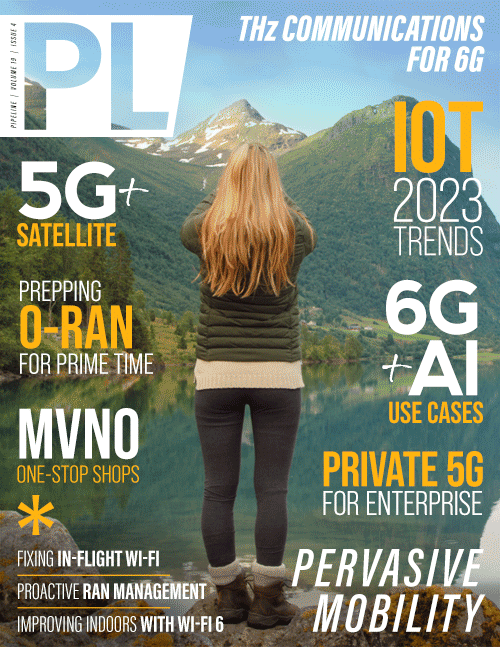By: Thomas Kurner
The possibility of using frequencies between 100 GHz and 1 THz for wireless communications—the so-called THz communications—has been discussed for almost two decades. The first concepts were
published in 2007. Especially the spectrum above 275 GHz allows the use of bandwidth in the order of several tens of GHz, which enable data rates of 100 Gbits and beyond with transmission schemes
of moderate complexity and spectral efficiencies. In the context of the development of the sixth generation (6G) of wireless communications, THz communications are discussed as an enabler to
realize wireless links with 1 Tbps…
» read this article
By: Mark Rasmussen
As the rollout of 5G coverage accelerates to include much of the world’s inhabited areas, mobile network operators (MNOs) rely on satellite connectivity to support the development and
deployment of the technology. As the next generation of satellite networks takes hold, the advantages of satellite will be even more profound—namely in the ubiquity, resiliency, and mobility of
these networks. More specifically, geostationary earth orbit (GEO) satellites cover large geographic areas from a fixed point approximately 36,000 km above the equator, synchronized with the
earth's orbit…
» read this article
By: Ken Figueredo
Within the Internet of things (IoT) market in its broadest sense, the pendulum of attention veered toward the consumer sector over the course of 2022. The impetus of behind-the-scenes
initiatives make this an obvious area to focus on in predicting 2023 market dynamics. In addition to momentum effects, however, other developments will shape future market dynamics. These include
market shocks, such as the global pandemic, that trigger and accelerate new developments. Fresh ideas from new entrants disrupt conventional thinking, leading to changes in user expectations, which
represents another avenue to predict future trends…
» read this article
By: James Kimery
Old hands in the enterprise software space know what happens when the sales and marketing promises get to the implementation crew: “But our product can’t do it!” As you might imagine, the
language of the technicians is often more spirited and colorful, but the real point here is that while promises are easy, delivery often is not. With this in mind, we turn our attention to one of
the hottest developments in the 5G space right now: Open Radio Access Network (Open RAN). The promises? A familiar hyperbole monologue of benefits, such as increased competition and lower costs
through open, standardized interfaces and software-defined architectures, along with new use cases and service models with intelligent controls and flexible, disaggregated, and virtualized
technology…
» read this article
By: Anita Doehler, Feifei Lou
Following NGMN’s “6G Drivers and Vision” publication in 2021, the publication of “6G Use Cases and Analysis” marks the next step toward NGMN’s work on 6G end-to-end requirements. The
identification of 6G use cases is key to predicting major trends in future usage scenarios and will help to steer the needs and requirements for future generational change. Therefore, operators,
technology suppliers, and academic advisors in NGMN joined forces and contributed their views on which 6G use cases they predict will emerge in the future decade…
» read this article
By: Miguel Carames
The global private 5G network market is expected to explode to $36.08 billion and a 47 percent compound annual growth rate (CAGR) by 2030 as advanced 5G private network use cases roll out, and
the full potential of 5G is realized. Mobile network operators (MNOs) have driven worldwide wireless network adoption, with continuous improvements from 2G to 3G and then 4G/LTE. However, 5G will
enable many new potential areas of growth—but also lower the barrier to entry for new competitors. How MNOs leverage this 5G opportunity while protecting and growing their mobile network market
share remains to be determined as they explore this new frontier…
» read this article
By: Matthew Halligan
The pandemic made the digital lifestyle a mainstream phenomenon and a global trend that’s no longer limited to digital natives such as twentysomethings. Virtually every demographic, including
senior citizens, has had to pivot to working, playing, and living online, such as subscribing to streaming video services rather than going to theaters. Each of those activities brings another
monthly bill. Wading through multiple bills each month is a hassle for consumers and enterprises alike. But it’s not a necessary evil…
» read this article
By: Tiago Rodrigues
Think about the last time your Internet connection went out at home or at work. It probably didn’t take more than a few panicky minutes before you started to feel less productive and cut off
from the rest of the world. And when your connection was restored, it gave you a newfound appreciation of just how much you rely on the Internet. So, it’s surprising how every day, millions of
people give up connectivity for hours on end simply because they’ve boarded a plane. That’s a problem for some passengers and airlines alike, but the good news is that Wi-Fi can be as available in
the air as it is on the ground…
» read this article
By: Nik Angelov
When the management of a mobile network operator looks at how to improve customer experience, the focus almost always falls on the network processes of fault management and operational health.
And indeed, no one would argue that when a fault occurs and services become unavailable, user experience will be impacted—hence the focus is justified. However, fault management is not the biggest
factor in the formation of long-term customer perception of what constitutes a great experience. Customers easily forget short and infrequent events when their service is down, but what sticks in
their minds are trivial yet persistent issues related to the service underperforming—for example, high latency in loading web pages or lengthy buffering when streaming video and music
services…
» read this article
By: Davide Quadrini
Despite the emergence of 5G, Wi-Fi will continue to play a critical role in enterprises' indoor connectivity strategies thanks to the new robust solutions based on Wi-Fi 6E and Wi-Fi 7
standards. In this article, we discuss the importance of seamless and secure Wi-Fi to enable use cases for successful enterprise engagement with customers and partners. Wi-Fi 6/6E rapid
adoption The Global System for Mobile Communications Association (GSMA) reported nearly 200 operators in more than 70 countries have deployed 5G networks, connecting almost a third of the
world’s population in 2022…
» read this article
By: Scott St. John, Pipeline
Access to information has always been essential and often the difference between who has power and who does not. But how—and how fast—we access information has radically changed. In the 1800s,
newspapers used the fabled Pony Express to gain the advantage on competitors by breaking news stories first. New York’s Courier and Enquirer published scooped accounts of President Andrew Jackson’s
annual message to Congress by paying for a horseback express from Washington to Baltimore, a ship to Philadelphia, and a second horseback express to New York City…
» read this article
By: Scott St. John, Pipeline
It’s been a busy month for tech news—but then again, what month isn’t? In noteworthy headlines, one airline is preparing streaming-fast satellite Wi-Fi for takeoff on regional service. Walmart
is rolling out drone delivery service, and a new cybersecurity study from Hornetsecurity finds that fully one-third of companies are not providing any cybersecurity awareness training to remote
workers—and with millions of us working remotely worldwide, that’s an alarming gap. The top telecom industry news stories from the month are summarized below…
» read this article
…
» read this article

















